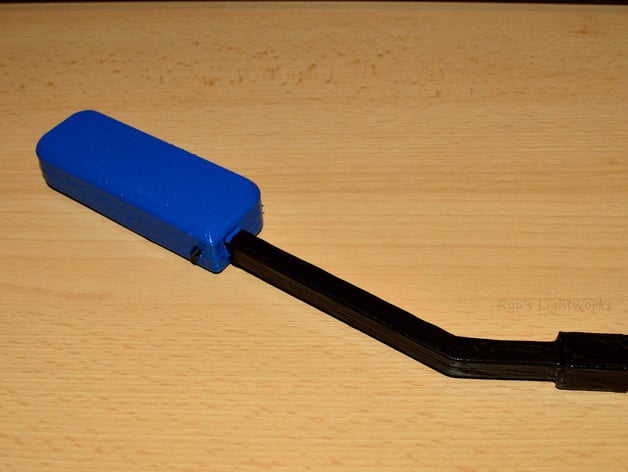
LightPainting LED Light Pen
thingiverse
This is my first LightPainting tool that I designed to a point where I believe it's perfect for its intended use. LightPainting is a form of photography in which a camera is set to long exposure and some elements are "painted" with light into a scene (or sometimes in pitch black). The second image shows an example I created with this tool. This is the most basic LightPainting tool, but it's very versatile and can be used for many different effects. I designed two versions of the handle. One is intended to be assembled with a push button, one with a switch. This light pen is usually assembled with a button because it's used by hand and fast on/off is often needed. However, in some cases a switch might be nice to have too in case you tape it to a rotating rod to create an orb or something like that. Print Settings Printer Brand: RepRap Printer: P3Steel Rafts: Doesn't Matter Supports: Doesn't Matter Notes: Depending on the material used (I used PETG, which is a pain to work with on overhangs and bridging) the lid and top part of handle need support. The rest is designed to work without any. Since the LED or other electronics shouldn't get hot, any material will do. Post-Printing After printing the parts should be checked for fit and cleaned of any irregularities that might be in the way. A super clean surface isn't really needed, so you can get away with printer settings that produce fast but lower quality prints. The arm and LED cap should be 100% opaque, so since I printed them in natural white I painted them with black paint. I also painted the handle blue because the LED I used in this example is blue, and once you use it for LightPainting it's essential to see what color your tool has without it emitting any light. Custom Section Needed vitamins In addition to the printed parts you will need: 1x regular 5mm LED 1x 9V battery 1x a resistor fitting for the LED and the power supply Cables Clip for battery 1x small tactile push button (6x6x9mm dimensions, sometimes called DIP buttons) or 1x micro switch (sometimes called SPDT PCB mini switches) Custom Section Assembly The cables have to be soldered to the LED first. Then the cables are guided through the arm, and the arm is designed in a way that the LEDs legs should fit and hold the LED in position. The cap is then put over the end of the arm and glued in position (I used ABS juice). Guide one cable through the hole on one side of the arm and solder the button to it as close as possible to the arm. The handle has a hole and a pin on one side that takes the arm and holds it in position. You can also glue it, if the fit isn't tight enough and the arm moves a bit. Solder the cables of the battery clip to the other side of the button and the second cable coming out of the arm. There is a small hole for the button on the side of the handle just above the end of the arm. The button is held in position by the arm itself, but can be glued too. Now put the other side of the handle on and make sure the battery clip is guided into the battery chamber. Once it fits glue the frame together. The battery chamber is closed by simply pushing one side of the lid into the grooves and fixing the other side with a small screw to the handle. I had no luck designing a proper lid so far (life hinged or clips never came out like I wanted them to), so I went for this easy solution. If you want the handle with the switch, the assembly is similar, but the switch is just a bit further away from the arm, so keep that in mind when soldering the switch to the cable coming from the LED.
With this file you will be able to print LightPainting LED Light Pen with your 3D printer. Click on the button and save the file on your computer to work, edit or customize your design. You can also find more 3D designs for printers on LightPainting LED Light Pen.
